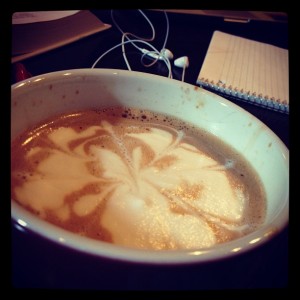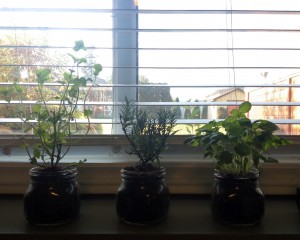This is what I have on an almost-daily basis (if I’m not running late, that is.)

Some Krema Greek Yogurt (about half a cup and I will opt for vanilla or “honeylicious”.)

A slice of coconut swirl bread… pre-made and bought from an “oriental express” store in Kelowna.

And a vanilla latte! (Home-made.)
So what is the break-down?
The Krema Greek Yogurt is:
- GMO Free
- certified organic
- sugar cane as a sweetener
- facility=meets and exceeds CFIA (Canadian Food Inspection Agency) standards
So how does the packaging work? THIS and THIS is what I could find.
So how is it being transported? More consciously than anything else I eat.
All in all, it seems as though Olympic Dairy is doing a great job in being more aware and careful of how their product is made and how it gets to your refrigerators. I perused the cyber-sphere to see if there was any information that says otherwise but failed to uncover any. Looks like this company is committed to sustaining our environment and are even open to suggestions! I tried e-mailing them today to see what kind of reply I would get and whether or not they would respond… I only e-mailed this morning so I’m still waiting on a response.
The Coconut Swirl Bread is:
- from T&T Supermarket in Vancouver (driven up to Kelowna)
- not organic
- packaged in cellophane
I couldn’t find much on the company’s practices apart from a wikipedia page and the “about us” tab on their website. From what I can tell, this is probably the least “environmentally aware” or the least sustainable food product I consume. Their breads are said to be made in their bakeries and their ingredients are not organic (which means they aren’t necessarily local either.) So not only is this loaf of bread being driven up to Kelowna from Vancouver, the ingredients that are being used to make it could possibly be shipped to Canada or flown over. Imagine how many different fossil fuels are being burned to get here! This reminds me of a video (one of my favourite summaries on fossil fuels) I had seen… and how I believe this company is definitely playing into an economy centred around the production of fossil fuels. (And this is why I’m switching over to bread products I know are made organically in Kelowna.) Also, this bread seems to be priced quite cheaply for how much travelling it has done. I wonder where these costs are being cut? If you read the wikipedia page on T&T, it discusses a legality issue it had with a worker that claimed they were being under-paid and over-worked. Having this issue raised (whether plausible or not) makes me question its’ practices. All in all, the company seems to be more focused on how quickly and efficiently they can have the dollars flowing in no matter what the cost.
And the packaging? Cellophane… not only are they putting toxic waste into the product, even more toxic waste is coming out via the factories and creating chemicals that have been synergistically intertwined. Now, THIS is the truly scary part.. the chemicals going into the products before manufacturing are tested and so are the different chemicals (for the most part) going in during manufacturing… these two sets of chemicals combined though…??? You guessed it, not being tested! There are large amounts of fossil fuels being burned to have this packaging produced and transported only to have it thrown into the garbage for it to be removed, transported, and dumped (as it can not be recycled- it actually says “Can not be recycled” on the packaging.) So even MORE fossil fuels are going into this bread after it has already been consumed.
The Vanilla Latte:
- home-made with my own espresso machine
- the syrup is from Starbucks
- the coffee beans are from Starbucks
- the milk is from Superstore (in Kelowna)
Finding any sort of information against Starbucks is, admittedly, difficult. I’m sure the corporation somehow regulates what information is out their about their business practices (maybe I’ll get an e-mail telling me to take down everything I am about to type… maybe not.) I will admit that they are clever in every aspect of marketing…
especially when I researched how they had successfully captured China.
However, this site was my gold mine for information. My coffee beans and my syrup are from all over the world in developing nations. Starbucks holds true to the “free market” mantra of “buy cheap, sell dearly,” which only means that not only am I spending a ton of money on these products but someone out there is being underpaid while the company is rolling in money.
It is probably safe to assume that Starbucks can afford to “spend big” on long-distance travels for their product whether it be via air or sea… which just means MORE fossil fuels! And more toxins being emitted into the atmosphere! They truly have made it difficult to find any sort of information on delivery, packaging, and manufacturing… this website even compares the Starbucks lack of transparency to trying to get the “Westboro Baptist Church members to show a glimmer of human decency.”
The milk itself is from “Foremost Dairies” which is owned by Loblaw. (Interestingly, so was T&T.. the supermarket that sells the coconut swirl bread.) And here is what I have found out… remember the Bangledash incident? (That was them.) Or how about the 200+ laid off workers? (That was them too.) Or the burger recall because of a threat of high E.coli levels? (Not Surprisingly…. them again.)
If THIS is what their business practices are. I can’t even imagine their manufacturing and delivery practices.
More specifically, the milk itself is from “Foremost Farms”- a large corporation in the U.S. This is the information that Foremost provides about their “Bulk Fluid Milk.”
Here is their write-up for where their farms are located:
“Who owns Foremost Farms? Foremost Farms is a dairy cooperative owned by about 2,000 dairy farmer-members in Illinois, Indiana, Iowa, Michigan, Minnesota, Ohio and Wisconsin. In 2011, they supplied 5.7 billion pounds of milk. We’re among the top 10 dairy cooperatives in the United States, and our annual sales were $1.7 billion in 2011.”
Here is where their manufacturing happens.
Interestingly, I found a video about their milk production in 1948. In this “picture,” they are already showing the “latest scientific technology.” If this is part of their beginnings- where are they now? My guess is- more “innovative” and “technologically” advanced than before. Which means… you guessed it, MORE fossil fuels being used. Not only is energy being used throughout the manufacturing and the delivery.. it is also going into the storage as it travels. Getting my milk from the U.S. seems unnecessary.. so why do I buy it? It is the cheapest milk out there. And again, costs are probably being cut somewhere (which means someone is suffering.) However, I failed to uncover where it is in the production line that makes this milk so cheap.





